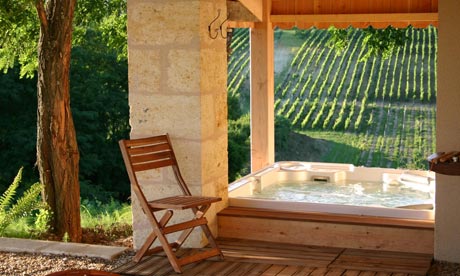
Grape escape ... La Maison des Vignes, Bordeaux
La Colombière, Burgundy
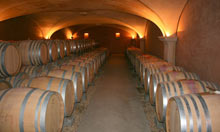
Tucked behind the town hall in the busy village of Vosne-Romanée is the maison d'hôtes of Anne Gros, a modern design that fuses stone, fired clay and ancient oak. Items like the state-of-the-art wood-burner and the modern art add a contemporary edge to this region famous for its traditions.
Anne abhors any snobbish associations with her beloved region, so don't expect the fussy formalities of the grand château here. You enter a large, light communal kitchen that is well-equipped – a boon for those keen to be creative with local delicacies from the busy markets at Beaune or Dijon. A well-stocked fridge contains a mix of fine wines from favoured estates – a sort of grand-cru minibar. Breakfast is self-service, too, with baguettes, croissants and, sometimes, homemade patisseries delivered each morning.
Up a twisting, modernist staircase are two large bedrooms and a family suite. For those with reduced mobility, there's another room downstairs. Each room is named after one of Anne's vineyards and has its own personality: there's the muted and minimalist Les Moines and the mandarin and limestone Les Loachausse, with wacky recycled sculptures.
Private tastings can be arranged although the list won't necessarily include the estate's own wines: demand often exceeds supply. The cellars are spectacular and well worth a visit. There's a small shady garden with recliners and parasols, and massage and beauty treatments are available. You can go truffle hunting in the forests of the Hautes-Côtes or borrow bikes; Anne is a keen walker and cyclist. She suggested to a couple of guests that instead of driving to her vineyard at Clos de Vougeot they should cycle. "Before they set off they were stressed executives. When they returned, they were smiling from ear to ear!"
• 11 rue des Communes, Vosne-Romanée, Côte-d'Or (0033 3 80 61 07 95, maison-lacolombiere.com), doubles from €75. Gîte for 11, €1,500 per week.
La Source des Fées, Burgundy
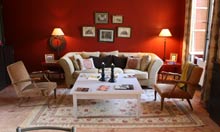
A hand-painted sign on an old barn door announces that you've arrived at La Source des Fées, where you'll find chickens and ducks scratching in the gravel of a shady courtyard and Naya, a French bulldog of a certain age. Close on her heels will be one of the hosts, winemakers Thierry Nouvel and Philippe Greffet, who bought the buildings in 2002 and began a four‑year restoration project. "Much of our produce is sold direct, so the chambres d'hôtes project was a natural extension of our wine business," recalls Philippe. "The work was hard, though; the earliest parts of the building are 13th century and the main bâtisse, built in 1656, had been empty since the mid 1970s." Bâtisse, in its pejorative sense, means "old pile", but don't be fooled: from the restored timber and stonework to the immaculate soft furnishings, antiques and collectibles, the restoration works have been carried out to a very high standard.
Upstairs, the two rooms – whose shuttered windows open to reveal views of the vineyard slopes – are larger than most Parisian apartments. Where another couple of rooms could have been squeezed into the layout, Thierry and Philippe have created a large, light salon where guests can relax on comfy sofas, read or even play the piano. Bread and croissants are brought from the village each day for breakfast, and the artisan jam and apple juice are produced locally.
Sitting beside the age-old spring that gave this place its name, it's hard to believe that the busy town of Mâcon is just 4km away, as is the TGV railway station on the main line from Paris. Guests arriving by train can spend a couple of days here without needing a car. You can get around on a hired mountain bike, and there's a good restaurant in the village.
Around six o'clock, the third member of the team, Gérald, invites guests to sample the excellent wines in the next-door salon de dégustation. Expect the unexpected: the pouilly fuissé matured in barrels made not from oak but from acacia wood. Chardonnay and gamay grapes from 10 hectares of vines harvested by hand go to make the estate's wines. "We are one of only a handful of producers here who harvest the grapes manually," Gérald says, which means they need a lot of labour at harvest time. "We announce the date of the harvest on our website. Everyone's welcome to come and pick grapes with us and help create the new wine."
After mountain biking through the steep vineyards or picking a few hundred kilos of grapes, book an ayurvedic massage. Then visit the estate's little shop where you can find interesting delicacies such as handmade chocolates flavoured with confit de vin or pêche de vigne confiture – and, of course, the estate's wines.
• Le Bourg, Route du May, Fuissé (+3 85 35 67 02, lasourcedesfees.com), 2 twins/doubles from €115-€145.
La Maison des Vignes, Bordeaux
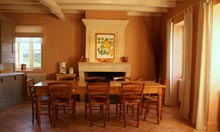
Sometimes life's most significant decisions begin as a frivolous dream. So it was for Pascal Méli when he spotted the details for "a winemaker's property of 15 hectares" near Bourg-en-Gironde. "I never imagined buying such an amazing place but I thought, 'why not take a look?'" Within six months, he and his wife Marielle had moved into Château Bujan and were celebrating their first grape harvest. "The following year we received gold and silver medals for our first ever vintage, the 1987," beams Pascal.
Twenty-two harvests later, and Bujan is still home to Pascal, Marielle and their three children. They have also found the time and resources to restore the beautiful Maison des Vignes, a 17th-century house overlooking the vine-strewn valley. In the kitchen-salon, chunky cream-painted beams and muted earth-coloured walls give a stylish and natural feel. Anything with a plug is discreetly hidden within the large oak dresser, painted the palest grey-blue. There's a serious oven and a battery of heavy pans. Dine at the pine table that seats up to eight guests, then flop on big, comfy sofas by the stone fireplace. Next door are two double bedrooms decorated in the same subtle colours, sharing a large bathroom with a magnificent claw-foot bath; upstairs are two more bedrooms. A rustic summer "dining room" at the back of the house is perfect for barbecues; beyond are the pool and gardens.
Pascal's vines benefit from near-perfect conditions and he is careful not to disrupt nature's balance. "We have five different grape varieties," he says, "merlot, cabernet sauvignon, cabernet franc, malbec and petit verdot. The climate and soil has a different effect on each."
The Bujan wines are elegant, complex and balanced. The Mélis have received many accolades including a Decanter World Wine award in 2006.
• Château Bujan, Gauriac, Gironde (+5 57 64 86 56, chateau-bujan.com), gîte for 8, €950-€1,900 per week.
Château La Villatade, Languedoc-Roussillon
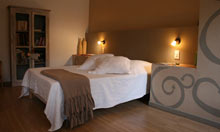
Villatade is a traditional campagne: a closed-courtyard farmhouse that, in its heyday, housed a self-sufficient community living off the land. Today only Denis and Sophie Morin live here. They had always been fond of the Minervois, so when they decided to start a new life, their quest began here, between Carcassonne and the Black Mountain. What they discovered was Château la Villatade, an ancient Languedocian farm with 22 hectares of vineyards and a square kilometre of pine forest and wild garrigue.
A couple of hikers who arrived looking for a bed one night inspired Sophie to name their ground-floor apartment The Walkers' Suite. No backpacker's bedroom, it's a little bolthole for two with kitchenette – charming, comfortable and contemporary. For larger groups, or those who wish to stay a week or more, there are two self-catering options. Once a barn with a hayloft above, Wine Cottage is now a beautiful split-level conversion with high beamed ceilings, terracotta floors and lime-washed walls. There are two double bedrooms and a bunkroom for kids. You can relax in the large, light living room or on the small, shady terrace. Within the thick stone walls of Villatade itself is Courtyard Cottage, a rustic-chic house on two floors with three double rooms and a children's bedroom. Both cottages have an open fireplace and a supply of logs.
There are horses in the paddock, a potager and a well-stocked trout pond. You can explore the untamed wilderness or stroll among the well-trained vines. A diverse mix of red Languedoc grape varieties includes one of the very few grapes to bear red juice – a Spanish variety called alicante.
To taste the wines you step inside a novel tasting room, an enormous 19th-century wine vat where, in times past, hundreds of hectolitres of grapes were turned into wine. Denis's wines have an aromatic complexity that Sophie says comes from the natural world. "We breathe in the aromas in the vineyard; in the winery we strive to capture them for the glass." Beyond the courtyard and the chestnut-shady grounds are breathtaking mountain-top panoramas, caves and gorges.
Nearby is Carcassonne, the finest fortified medieval city in Europe.
• La Villatade, Sallèles Cabardès, Aude, Languedoc (+4 68 77 57 51, villatade.com), doubles from €60-€80, two gîtes sleep 2-9, from €400 per week.
L'Ameline, Loire
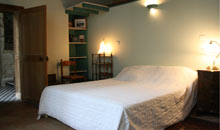
The village of Pouilly clings to a raised côteau on the right bank of the Loire, and its steep, narrow streets all seem to go riverwards. Walk down to the old quays at the water's edge and you pass the winery, cellars and maison d'hôtes of Jean-Pierre Chamoux.
The Chamouxs produce two wines: the flinty and aromatic les arables, from old vines on the higher slopes, and the fruity and fresh chantalouettes made from younger vines. Jean-Pierre and his wife Sylvie are generous, hospitable and down-to-earth. As for the maison d'hôte – an old lawyer's house – it stands behind the main house in a small geranium-spilling courtyard. A sympathetic eye has been used to forge three bedrooms for guests. There are stone walls, oak beams, a hallway with beautiful tessellated tiles, and bedrooms that are comfortable rather than plush.
Jean-Pierre and Sylvie serve food that matches perfectly the zesty bone-dry wines. When asked what classic fish dish Jean-Pierre recommends, he replies, "Oh, just some pétoncles [queen scallops] marinated in orange juice with a couple of finely chopped peppers, sautéed in a little hazelnut oil." Such understatement masks his innate understanding of the complexities of matching food with wine. The pouilly-fumés go equally well with freshwater fish and cheese (local, of course), but a sweet wine from further downriver is chosen to accompany dessert.
The region, its cuisine and its famous white wines have become Jean-Pierre's passions. "Food and wine bring people from different countries and cultures together. As a meal progresses, people's experiences, ideas and dreams are shared."
Walkers can follow a number of well-marked paths along the riverside and into the wooded hills, while the regional nature reserve of the Val de Loire can be explored on foot or by kayak. Get out early and you may glimpse a dam-building beaver.
• 1 rue Ferdinand Gambon, Pouilly sur Loire (+3 86 39 15 58, ameline58.fr), 3 twins/doubles from €53.
Domaine de Beauséjour, Loire
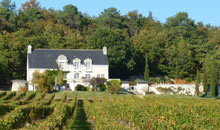
This fabulous property rests in the famous Chinon vineyards, on the limestone coteaux of the Vienne valley. Looking out on to a swathe of vines covering the valley, Marie-Claude Chauveau recalls there wasn't a single vine when they moved here. "Every viticulteur takes a long view, though. He plants a vineyard, he prunes, he works the soil, and all the while knows many years will pass before it yields fruit."
Marie-Claude's husband Gérard, an architect, inherited Beauséjour from his father and planted the vines that now grace these slopes. Forty seasons have come and gone since then, and the fruit of the harvest makes a rich red wine. Gérard, now in his 80s, has seen his son David continuing the tradition.
In the midst of this sea of vines lies the couple's home and their delightful B&B. The house, built in pale tuffeau stone, was completed in 1978 but its architectural style comes from the previous century. Set between the forest and the vineyards, the grand three-storey house and faux pigeon tower have an air of 19th-century elegance. Linking the two, a terrace and a pool overlook the verdant valley and, behind them, a troglodyte cave makes a wonderful alfresco dining room. For guests, there are two bedrooms in the tower (one up, with views, one down, opening on to the pool), and a peaceful, pretty two-bedroom suite on the ground floor of the main house. The interiors are bright and smart – mellow stone walls adorned with old prints and portraits and antique Persian rugs on black slate.
When Gérard built the house, he also built the winery – a semi-subterranean cellar in the hillside containing a huge, ultra-modern vat room. Beyond the rows of shiny stainless steel vats is a gallery, 150m long, stocked with bottles and barrels. He restored the original 18th-century farm buildings, too, where you can sample Beauséjour's award-winning chinon wines. Marie-Claude gives an entertaining dégustation in English or French, and explains the importance of the vintage. "Our vineyard is sheltered from the north by the hilltop forest and its south-facing slope maximises the sun's warmth. But each year brings with it a unique pattern of weather that influences the wine." You'll discover, in the glass, how climate alone can create such differing characteristics.
At breakfast, plan a day's walking or cycling (a Grande Randonnée footpath passes nearby), or a tour of the local wine estates. Chinon is only 10 minutes away and the 12th-century castle should not be missed. For garden lovers, the Château de Villandry is dazzling, with a vast potager divided into nine equal squares, stuffed with ornamental cabbages, radishes, peas, strawberries, sorrel, leeks, forget-me-nots and daisies, that is replanted twice a year.
• Panzoult, Indre-et-Loire Valley (+2 47 586 464, domainedebeausejour.com), doubles from €70-€90; €120 for 4.
Château de la Tuilerie, Rhône
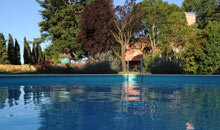
Caesar's legions, returning from the Egyptian wars, were given lands on the fertile plain of Nîmes. Beautifully preserved, the amphitheatre and aqueduct recall the city's history, and in the fields all around grows another Roman legacy: the grapevine.
On a gentle rise of north-facing vineyards between the city and the sea is one of the southern Rhône's most celebrated wine properties. Château de la Tuilerie is the family estate of Chantal Comte, a progressive and charismatic winemaker whose labels are adorned with fine art motifs.
Open-air recitals fill the summer evenings with music, and original works deck the walls of the Bastide – a stylish and opulent holiday house in the heart of the vineyards.
La Bastide de Fabrègues is a prestigious 18th-century building in a beautiful walled garden where oleanders and English roses flourish. In coral pink, with a balconied first floor above a wrought-iron arcade, the house has a serene, colonial charm. Behind the stone walls, a cool, bright interior includes a large living room full of deep sofas and a peaceful well-stocked library. For informal dining you have a butler's pantry kitchen; for grand dinners, a large dining room with an oak refectory table. Upstairs are three big double bedrooms furnished with fine antiques and decorated with paintings and engravings. The king-size beds are dressed with hand-embroidered cotton percale and each room opens on to a sunny balcony looking over the orangery and lily pond. You can bathe in a pristine circular pool or snooze in a hammock strung between century-old trees.
A 20-minute walk from the Bastide takes you through the vineyards to the wine-tasting cellar. Chantal knows her wines – and her rums: she bottles fine aged rum from the island of Marie-Galante in Guadeloupe.
• La Bastide de Fabrègues, 571 Chemin de la Tuilerie, Nîmes (+4 66 70 07 52, labastidedefabregues.com), gîte for 6, €2,000-€3,000 per week.
Le Vieux Cèdre, Champagne
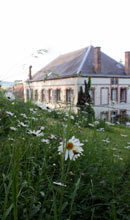
In the Côte des Blancs, the wine route leads south from Epernay past the vineyards and through the little village of Avize. Le Vieux Cèdre is almost in the centre of the town but the steep garden rises behind the house to meet the vineyards that crowd in above it.
This is the family home of Didier Pierson, a fifth-generation member of a champagne winemaking family, and his English wife, Imogen Whitaker. Wanting to create their own champagne marque – Pierson-Whitaker – they moved to this house 12 years ago.
From the high-walled front courtyard, a double-curved staircase leads to an airy, black-and-white tiled hall. A 19th-century oak staircase brings you to a first-floor landing, from which you reach three smart bedrooms with high ceilings, polished beech floorboards and original doors and mouldings.
Downstairs is a relaxed living room filled with photographs and paintings by friends and family. The adjoining dining room is where your hosts' talents are revealed: Imogen creates delicious dishes to match Didier's excellent champagnes. You can sample a different fizz with each course: a pure chardonnay blanc de blancs with the aperitif and a salad dressed with flambéed Langres cheese; an elegant assemblage to accompany the main course; and a rosé with dessert. For the cheese course, Didier serves a sweet ratafia made from Marc de Champagne and chardonnay grape juice.
Didier divides his time between his premier cru vineyards here and the 28 acres he has recently planted in the Meon valley in Hampshire. He explains, "There's little room to plant more vines in Champagne, but the climate and geology of the South Downs are perfect."
• 14 route d'Oger, Avize (+3 26 57 77 04), 3 doubles/twins from €65.
La Cour du Bailli, Alsace
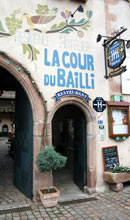
The fortifications encircling Bergheim recall the town's medieval past; its double line of defensive walls, gateways and towers are better preserved than those in other villages along the Alsace wine route. The Halbeisen family, whose forbears include a knight of Emperor Frederick III, came here in 1737, starting a wine dynasty that has flourished for more than 250 years.
The winery is a short stroll from their splendid hotel and spa – La Cour du Bailli. Horse-drawn wagons once trundled through the grand arched gateway. Now the courtyard of La Cour has prettily laid tables and colourful pots and baskets. Beneath the courtyard is a dining room in the stone vaults of an ancient wine cellar.
A vine-festooned gallery leads to the bedrooms where beautiful, 18th-century painted interiors and furniture, dark panelled timber floors, and oak beams have been conserved.On the first floor, overlooking the quad, and in an adjoining farmhouse, are 38 studios and apartments, the largest of which have balconies or patios with views of Bergheim's pantiled roofs and forested hills. Below the farm are treatment rooms and a spa where you can bathe in a pool built inside an ancient barrel vault, relax in the sanarium ("not as hot as a sauna and less steamy than a hammam"), or try grape-based body treatments.
From La Cour you cross the ramparts and the little Bergenbach river to reach the winery. Seven grape varieties are cultivated on Bergheim's marl and limestone slopes, including a pinot noir and a sublime riesling from the south-facing grand cru vineyard of Altenberg just behind the winery.
A little knowledge gained at the winery will prepare you for the restaurant's impressive wine list. Several of the wines are used to prepare rich, wholesome dishes such as terrine au muscat or coq au riesling. The wines make it into the desserts, too – try the fruit pudding kougelhopf served with Marc de Gewürztraminer ice-cream.
• 57 grand rue, Bergheim, Haut-Rhin (+3 89 73 73 46, cour-bailli.com), doubles from €71-€185. Two gîtes for 4 from €102-€115 per night.
Domaine du Fogolar, Provence
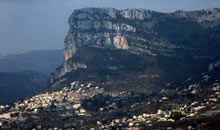
High in the hills above the suburbs of Nice, perched on a steep slope reached via vertiginous hairpin bends, is a fascinating winery. Jean Spizzo, originally from the Friuli in northern Italy, bought the house and planted the first vines here more than 30 years ago. He named the domaine "Fogolar", which means "hearth and home" in his native Friulian. From the terrace the view is inspiring: vineyards descending to almond trees, with the Var valley and the rocky promontory of the Baou de Saint-Jeannet towering hundreds of metres above the river gorge.
"We wanted to make the most of the wonderful views, the light and the sun," says Jean, gazing at the distant mountains from the balcony of the gîte. "The living room opens on to south- and west-facing terraces, and from the upstairs bedrooms you emerge on to an enclosed roof terrace." Furnishings are simple: kilim-covered terracotta floors, leather armchairs and country furniture. This is such a peaceful spot, it's easy to forget that you're only a few minutes' drive from the Riviera.
Further up the slopes, a little way from the gîte, is the couple's family home, the winery and a small tasting salon. As diverse and vibrant as the colourful paintings that line the walls, Jean's rare bellet wines are packed with aromas and flavour. White, red and rosé lovers will be delighted to discover these relatively unknown gems from France's most easterly vines.
"We have steep slopes of pebbly rock called poudingue [from the English word pudding stone] and a mix of local grape varieties rarely found elsewhere," says Jean. Thyme, grasses and wild flowers grow between the vine rows, and insecticides are banned. The result of Jean's unique terroir is a wine that wins medals year after year.
• Collet de Bovis, 370 Chemin de Cremat (+4 93 37 82 52, vin-de-bellet.com), gîte for 10, €800-€1,100 per week.
Ref: guardian.co.uk